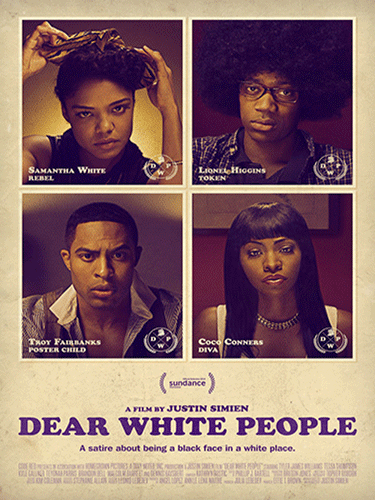
The Scene staff
“Dear White People” is a satirical drama that will cause viewers to discuss and think more deeply about racism in 2014.
Director Justin Simien’s debut film is set on an Ivy League campus, where racial tensions are running high. The administration decides to diversify housing, leading black students to take action to preserve their culturally centered residential hall. Conflict comes to a head when white students throw a thug-themed blackface party.
Throughout the film, one of the main characters, Samantha White, hosts a radio show called “Dear White People,” giving white people tips on how to behave around blacks. For example, “Dear white people, please stop touching our hair. Do I look like a petting zoo to you?”
The movie is fictional, but the dialogue and situations are relevant today. In the past three years, most movies about race have been period films. That includes “Django Unchained,” “12 Years a Slave” and “The Butler.”
It seems like the movie industry is making a point to show America how far we’ve come and how much things have changed. White people are able to leave theaters feeling good about themselves, thinking “blacks aren’t treated badly anymore, so everything is fine.”
Many people like to use the phrase “post-racial America” to describe our society. But a closer look reveals that relations between the two races are still tense.
This past Halloween, the Internet was buzzing with photos of white people who thought wearing blackface as part of their costumes was funny.
Comment sections on stltoday.com can be racist wastelands, where people throw out their bigoted opinions while hiding behind computer screens. Whether you are watching the news, reading blogs or standing in line at the grocery store, conversations make it clear that America has a race problem.
“Dear White People” is an important film because it shows racism in the present, using language and images we all recognize. It doesn’t present it as an archaic concept, like movies set during slavery or Jim Crow days.

Simien’s film is about tension between blacks and whites, but that doesn’t necessarily mean a line has been drawn in the sand, with the entire black race on one side and the entire white race on the other.
In the movie, two black female characters disagree about racial issues on campus. One is militant and outspoken, while the other feels like it is better just to blend in. This directly parallels everyday conversations in the black community.
I saw the film with my friend, and on our way home, we got into a huge argument about it. Passion was high and tension was thick. Voices were raised and profanity was used.
I felt betrayed by my friend’s opposing views. We are both black women in our 20s. I just assumed she would think the same way I did.
Since then, we’ve apologized and agreed to respectfully disagree. But this goes to show that opinions on race relations can vary greatly, even among people in the same race.
All the characters in “Dear White People” have different storylines and important messages, but most are one-dimensional. Those with a chance of being complex fall flat. Something is missing.
The major plot holds up well, but a subplot about a reality show is confusing and out of place. The director could have saved it for a sequel or TV series.
The dialogue and jokes are sharp and witty. The hair and wardrobe are amazing. I got tons of ideas for outfits. It was refreshing to watch a film with people who looked and talked like me instead of what society imagines.
Despite a few cinematic flaws, “Dear White People” is an awesome movie. Anyone between 17 and 25 would definitely enjoy it. However, the over-30 crowd might not relate as well or get the humor or cultural references.
Unlike other films about racism, this one has a comedic air. The topic is very serious, but it was handled in a way that didn’t leave me feeling angry or sad.
The film ends ambiguously, which makes sense to me. The story of race isn’t over in America. In fact, I think it’s just beginning for my generation.
“Dear White People” opens the window for a positive discussion about race in the United States today. It is sure to entertain, educate and enlighten.
